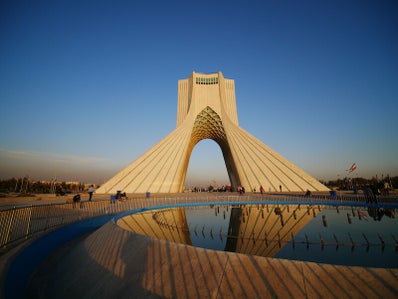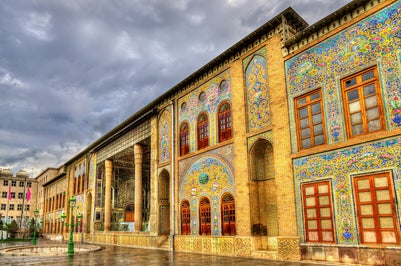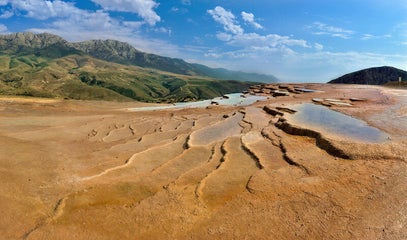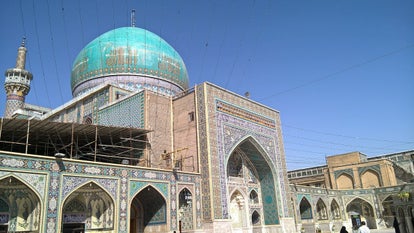Iran and Turkmenistan Tour Program

Day 1 Arrival Tehran
You arrive in the capital of Iran and will be met on the airport by our representative, who will escort you to the hotel


Day 2 Tehran
The first day of your trip is a visit of the capital city, Tehran, the largest metropolitan city in the Middle East. Tehran never sleeps. This large city during recent history of Iran was the home of very important events. To discover Tehran and its different lives and lifestyle one day is not enough. You will be amazed how tradition and modernity come together and make the structure of this city. There is plenty to do and see in Tehran. Depends on what you like to do, Tehran can offer you many of interesting museums, traditional and local bazars, modern shopping centers, galleries of modern art, parks, mountains, ski resort in the season, historic buildings, modern architecture, street foods, hipster café , high-end classy restaurants … for a classic city tour in Tehran we may suggest you to have a visit of National Museum. This museum has two exhibitions, The Museum of Ancient Iran and the Museum of Islamic Art and Architecture. We may suggest you to pay a visit to this museum in order to have a general idea of what you will visit on your next days of your travelling.
The other place which can be suggested is the Golestan Palace , which is one of the oldest historic places in the city and formerly was the royal Qajar complex. The complex of Golestan Palace consists of 17 structures, including palaces, museums, and halls. Golestan palace has a collection of Iranian crafts and European presents from the 18th and 19th centuries. If it fits to your program do not miss Treasury of National Jewels and be fascinated by all the gemstones and the history behind each piece. The Grand Bazaar of Tehran is one of the places you should visit. Tehran Grand Bazaar splits into several corridors and each specializes in different types of goods. So far you are in the old part of Tehran, to get some idea about the modern part of the city you should drive to north of the city and spend some times in Nature Bridge (Pol-e Tabiat) and sit and relax in one of the many cafes and get refresh while you have a view of Tehran.
This list is few places in Tehran that you can visit. You can always ask us for more detailed information.

Day 3 Tehran - Semnam
Today after breakfast you drive toward east of the country to Semnan city, the capital of Semnan province. When you leave Tehran after Khavarshahr on your left you see a small white church, there is Tehran Armenian Cemetery or Borastan cemetery belongs to Armenian Apostolic church in Tehran. Borastan Monastery is the only Armenian cemetery in Tehran and has a chapel called the "Holy Stepanos".
You will pass some few cities and some industrial sites and then you reach Sar Darre Mountains, very interesting colorful rocky mountains also known as Martian Hills, on the edge of Dasht-e Kavir, Iran’s largest desert. Inside these mountains there are many salt mines and they also serve many tourists, especially domestic tourists during the year. After these mountains you have the city of Garmsar on your way. This area embodies ancient history. In Garmsar, there is a castle called Stonavand, which is estimated to be more than 3500 years old. And the paved road from Garmsar to the heart of the desert and to Qasr Bahram Caravanserai is one of the most prominent ways of the Safavid period, the traces of which still remain today. The vast and beautiful desert plain of Garmsar, which is the front of the central desert of Iran, has many natural attractions, which is also known as the first habitat of the Iranian cheetah. There are many historical villages around Garmsar such as Padeh, where you can visit historical water reservoir and an old hammam (bathhouse). Garmsar is known all over Iran for its yellow melons, very crispy and sweet, better known as the ‘Honey of Garmsar’. The city is also famous for the dish “Tahchin” very much different from other Tahchin which is known in other cities of Iran and fig trees. If you like we can organize to have lunch in a local home and try the best Tahchin and then back to the road.
Semnan; city of daffodils, Shirmal pastry (a saffron-flavored traditional flatbread) and Kilim Rug, may not be very well-known among foreign tourists. But historically this is one of the fourteen civil foundations in ancient era and also an important city during Achaemenid Empire. Semnan was also very famous city during Parthian and Sassanid era. And when Muslim came to Persia, Islam was established in Semnan. During Qajar Period Semnan raised economically and politically. Important sites to visit in Semnan are the Semnan Jame Mosque with over 1000 years of history, Imam Mosque ( known also as Soltani Mosque) designed by expert Iranian architects of Qajar time, the Shrine of Sheikh Ala'ed-dowleh Semnani built during Safavid dynasty, the Gate of the Semnan Fortress, Semnan Bazaar and Pehne Bazaar, Taddayon House …

Day 4 Semnam - Damghan via Badab-e Surt
Today you will leave Semnan to Damghan, another city in Seman province. But before going to Damghan you leave Semnan province and you enter Mazandaran province to see one of the natural phenomena of the world. On your way you pass Mehdi Shahr and Shahmirzad, summer country sides for Semnani people, and since you have a busy day you better not to make stop. After 2 hours and 30 minutes driving you will arrive to Qale- Sar village, where at some point you need to change your transportation because your car cannot drive in last few kilometers remains to the splendid Badab-e Surt spring. It contains a range of stepped travertine terrace that have been created by flowing water from two mineral hot springs deposited carbonate minerals. Of this phenomena there are four in the world, Mammoth Hot Springs in the USA, Pamukkale in Turkey, Huanglong Scenic and Historic Area in China and this one you are visiting . In the late afternoon you will be in Damghan. This city is the oldest and the most ancient Parthian city in Iran and was one of the first capitals of Parthian Empire. But it’s history dates back to far before Parthian and it is estimated over 7000 years ago. Damghan has many historic sites, the oldest one is Tappe Hessar that contains the ruins of Sassanid castle. The mosque of Damghan, Tarikhaneh is one of the oldest one in Iran and it was a fire temple during Sassanid era but converted to mosque after the raise of Islam. You can visit city fortification and Sassanid architecture, Chehel Dokhtaran Vault. Damghan is very much famous for its pistachio and paper almond. Among the famous dishes in Damghan you may like to try Sabzi Polo, Mani Polo and walnut stew.

Day 5 Damghan - Gorgan / visit Gonbad-e Qavus
In a few hours you will drive to Gorgan, the capital of Golestan province, located near the Caspian Sea. This city was an important cultural and trade center in north of Iran and known as Verkana in old Persian and Hyrcania in Greek sources, destroyed completely during the Mongol invasion. Gorgan has many archeological sites in and around the city and based on the excavation historians believe the first inhabitation in the city dates back to 678 BC.
Gorgan is the birthplace of Agha Mohammad Khan, the founder of Qajar dynasty, and it was flourished during Qajar period.
In the afternoon visit of “the Tower of Kavus” or Gonbad-e Qabus. The city of Gonbad Kavous, with a history of five to six thousand years, and its great economic importance as the center of the Turkmen Sahara, is the most important city in Golestan province after Gorgan. During the reign of Al-Ziar, the province of Gorgan was of great importance. One of the governors of this important province, Kavous bin Vashmigir bin Ziar, was an efficient prince, and Will Durant also mentioned him in his History of Civilization. His tomb, Gonbad-e Qabus is one of the most important buildings in the history of Iranian architecture, which with a height of 72 meters, has been named the tallest all-brick tower in the world.
Another point of interest of this region is the “Divar-i Gorgan”. Gorgan's defensive wall, also known in historical books as Alexander's Great Wall or the Red Wall, This wall is almost as ancient as the Great Wall of China. Among the residents of this region, Gorgan's defensive wall is also known as "Red Snake" and the reason is the use of red bricks in the middle of the wall. According to experts, this wall, like the Great Wall of China, was built to defend the country's borders and counter the influence of enemies. For many archeologists it is difficult to determine when exactly the wall was built, as the name of Medes, Achaemenids, Parthians, and Sassanids are among the books of experts. But most historians believe this wall was built in Sassanid era. The remaining part of this wall is possible to visit in north of Bandar Torkman.

Day 6 Gorgan / visit Turkmen Sahra
After a pleasant breakfast you will explore the great landscapes of Golestan Province. This province is ethnically the most fascinating in Iran. Many Sunni Turkmens, Baluchis, Georgians and Christian Armenians live in the area.
You will drive along the rolling hills of Turkmen Sahra and visit the ancient mausoleum of Khaled Nabi. Around 600 tombstones, all from pre-islamic times, can be found here.

Day 7 Gorgan- Mashad
T oday you will drive to second most populated city of Iran and very famous among Shia Muslim, Mashad. The city Mashad itself was not a famous city in ancient time and gained all its fame after the martyrdom of Imam Reza, the 8th Imam of Shia Muslim, who is buried in this city. Every year millions of pilgrimages visit Imam Reza Shrine. Because of so many visitors Mashad has huge number of hotels, specially the most luxurious ones, after some nights in rural homestays maybe a bit of luxury is not that bad!
In Mashad beside the Shrine of Imam Reza, you can visit the museum of Astan-e Qods Razavi which mostly related to Islamic period. You can visit a valuable collection of ancient Qurans. And you can visit the masterpieces of famous calligrapher Reza Abbasi belongs to Safavid era. Rugs and woven textiles in this museum are also interesting artefacts to see.
The other monument that catches your eyes is Goharshad mosque, in the south side of the shrine. This mosque was built during Timurid period under the order of Goharshad, Shahrukh’s wife. The elegance and beauty of the titles, calligraphy and architectural style makes this masque as one of the masterpieces of Iranian architect in Timurid period and due to the closeness to shrine of Imam Reza, this mosque is one of the most visited mosques in Iran. The other places you may like to visit in Mashad are Nadir Shah Afshar Tomb and Darougheh House.

Day 8 Mashad / visit Neyshabur and Tus
Today after breakfast you make an excursion to cities near Mashad. First you drive to Neyshabur.
This town was founded during Sassanid dynasty, but has been destroyed and rebuilt many times. Neyshabur had a great position in old Silk Road and it linked west to China.
Neyshabur was very famous for its pottery works during the 9th and 10th century, the Islamic golden ages. Many of the discovered ceramic works from this region now are exhibited in Metropolitan Museum of Art.
Still there are 4 pottery workshops in Neyshabur. This city is also very much known for its carpets and rugs. But one special thing that has worldwide fame is Neyshabur Turquoise.
This region is the home of many famous and notable people. The legendry Omar Khayyam, famous Iranian poet, astronomer and mathematician was from Neyshabour. His Rubaiyat is very much popular in the west. The other famous person of this area is Attar. He was Persian poem and theoretician of Sufism. You can visit the mausoleums of Khayyam and Attar today.
Your next visit will be Tus. Tus is an ancient city in Iran. It is the city of Ferdowsi, author of the Persian epic Shahnameh. You can also visit Harounieh dome, which is believed that the 11th century great Persian philosopher and theologian, Al Ghazali rest here.
For the evening we may suggest you to drive to Shandiz. Not only to cool down in cooler Shandiz, but also ry the best shishlik kebab of the world (of course if you are not a vegetarian).

Day 9 Mashad - Ashgabat
t's time to say goodbye to Iran and be welcomed in a new country; Turkmenistan. You will travel to the border of Badjgiran. After visa procedures you will be welcomed by our team from Turkmenistan. You will be driven to capital Ashgabat.

Day 10 Ashgabat
The Turkmen capital is very vast and full of statues, squares and past palaces (the palaces themselves cannot be visited). With any luck, you will end up in one of the squares in a wedding procession and can participate in a photo session in front of a golden statue of Turkmenbashi and marvel at the tapestry-like veils in which the brides are enveloped.
You will visit the Ertugrul Gazi Mosque, one of the most beautiful Islamic mosques in Turkmenistan. Like all other buildings built in Ashgabat during the period of independence, the mosque stands out with its size and rich decoration. Located in the heart of the city, this mosque can accommodate up to 5,000 people. You will also visit the National Museum in Ashgabat consisting of three different museums: History Museum, Nature & Ethnographic Museum & Presidential Museum. You can choose which museum you are interested in. Of course, a visit to the Monument of Neutrality should not be missed during your city tour. The 95-meter high monument has the shape of a lighthouse supported on three pillars. On two pillars are cable cars that take visitors to the second floor of the monument where a restaurant is located. A glass elevator takes visitors to a height of 50 meters where there is a viewing platform. Atop the monument is a golden statue of Turkmenistan's first president - Saparmurat Niyazov - stretching his arms to the sky with a flying flag in the background. After President Saparmurat Niyazov died of heart failure in 2006, his successor Gurbanguly Berdymukhamedov decided to banish the monument to a suburb of Ashgabat where it has stood since 2010.
If you are in Ashgabat on a Thursday, Saturday or Sunday then a visit to the Tolkuchka bazaar is worthwhile. This market reaches its peak on Sundays (with the trade in animals). It is a true paradise for photographers, but even without a camera you will feast your eyes. Everywhere gray-bearded Turkmen with colorful hats, sturdy boots and long coats. Especially at the cattle market you will feel as if you are centuries behind when you see the buying and selling of camels. Sheep, goats, cattle and chickens are also traded. But also cars, buses and trucks. Most colorful is the huge carpet bazaar. Here you will find mostly women in flowered dresses with bright head scarves sitting on huge piles of carpets. Large, small, cheap, expensive, antique and factory carpets, you will find it all there. Buy your own coat, or a fur hat, Turkmen jewelry or Soviet attributes? All possible. And of course a seemingly endless amount of vegetables, fruits, fresh breads, dairy products and cheap textiles and products from China.

Day 11 Ashgabat - Serdar via Geok Depe and Nohur
You will explore the Kopet Dag mountains. On the way to Nohur, you will visit the Turkmenbashi Mosque and the mausoleum where the first president of independent Turkmenistan and his family are buried. The mosque is the largest in Central Asia and, quite in style, is built of Italian white marble. Another stop is in Geok Depe to tour the Mosque commemorating the Battle of Geok Depe. In the years 1879-1881, the tsarist army had the greatest difficulty in putting down the revolt of the local Teke tribe, against this new regime. Further west, Nohur is a village that has retained its authentic lifestyle, hidden as it is in a remote valley in the Kopet Dag mountains. Nohur is famous for the silk cloths that are woven here according to an ancient technique (keteni). In addition, behind the village is a unique cemetery. The number of horns on each grave reflects the importance of the deceased. The hills surrounding Nohur are beautiful and ideal for a picnic. You will also find the Turkmen shepherd dogs, the Alabay. The Nohuris consider themselves a distinct Turkmen tribe and descendants of Alexander the Great. From Nohur you will travel on to Serdar where you will spend the night in a guesthouse.

Day 12 Serdar - Mary / visit Merw
By new road you will drive to Mary, from where you will be visiting one of the legendary cities of the ancient Silk Road: Merw. A huge area of ancient ruins, with a few protruding buildings. One of the most distinctive buildings is the Kyz Kala palace, used from the 7th to 11th centuries. Dromedaries usually graze around the palace. The city was built in the 6th-century BC as part of the Aechemenid empire. That empire was defeated in the 3rd-century BC by Alexander the Great, although it is uncertain whether he himself visited Merw. Subsequently, the city became one of the most important centers in the empire of the Seleucids, the Bactrians, the Parthians and the Sassanids.
In the 11th century, the city revived as the eastern capital of the Seljuk Empire and even grew to become one of the most important cities in the Islamic world. But eventually this city too fell to the destructive power of Djenghiz Khan and his Mongol troops. Since then, the city has been at the mercy of the desert sands. Not surprisingly, a city with such a rich past actually consists of many cities, each recalling a different era. And much of the past is still buried underground. But even now you can feel the history shimmering through the desert heat.
.

Day 13 Mary - Margush - Karakum desert
Deser Adventure awaits. You will pass the oldest Bronze Age remains at Gonur Depe on the former Murgab River delta. The complex was only discovered in 1971, leaving archaeological teams with much work to do. Gonur Depe is the center of the Margush area, also called BMAC in archaeological terms: Bactrian-Margush Archaeological Culture. There is a great debate in the archaeological world as to whether Margush can be called the fifth Antique Civilization, alongside India, China, Egypt and Mesopotamia. Either way, a visit to Gonur Depe is impressive. It is the precursor to Merw, which is about 100 kilometers away. The river Murgab changed its course to Merw in a span of about two thousand years. Next, a trip through the desert, taking you to the village of Murzachirla, where you will spend the night in tents.

Day 14 Karakum desert - Darwaza
Today you will travel "off-road" all day and trek across the Karakum Desert. The route goes over the hard clay soil of former river beds and over sand dunes. Sometimes you will come to water sources, where groups of sheep and goats feast on the water before being driven on by their shepherds in search of a fresh snack from a "saksaul" tree or a "camel thorn" bush. You can also refresh yourself there, and have a chat with the "crew" of the spring, who operate the pump. In the small desert settlements of Damla and Ak Molla, you will be introduced to life in the desert. The whole village spills out, boys on motorcycles come from everywhere, and the women offer you tea and camel milk. These villages are completely cut off from the world, and have no gas, water, electricity or telephone connections. You can study the yurts and admire the herds of camels. You will ride until sunset, after which you will sleep in a yurt camp near the gas crater of Darwaza. This gas crater in the desert has been on fire for decades. Not a natural phenomenon, but a mistake made by Soviet geologists. In the 1970s, drilling was done here in search of oil and gas. Suddenly the ground collapsed, they had stumbled upon an underground cave system and a gas deposit. The gas spread through the cave system. The geologists thought they could solve the problem by burning up the gas and wisely set it on fire. The gas is still burning.
Especially at night, this provides a stunning image; the desert desert and the burning fire. You will spend the night in a shared yurt or private tent in the middle of the desert. Near the fireplace you will enjoy a typical Turkmen barbecue.

Day 15 Darwaza - Ashgabat
You will return to the Turkmen capital. Here you will spend the last evening of this wonderful tour through unknown destinations.
Day 16 depart Ashgabat